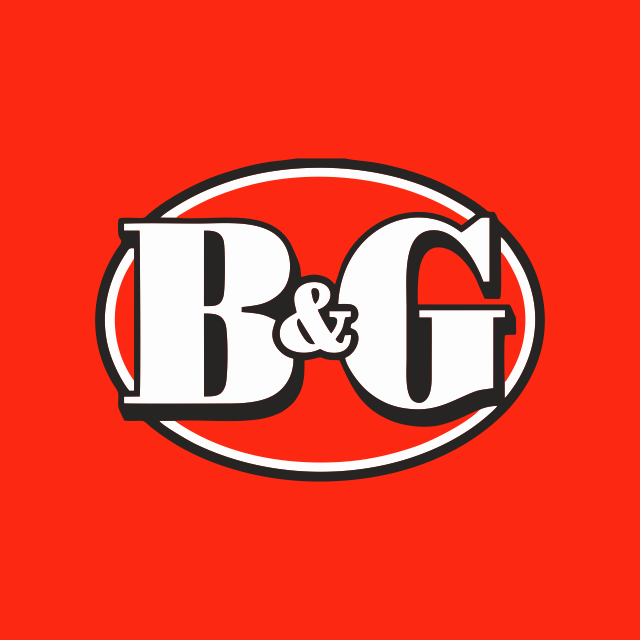Company Analysis B&G Foods
1. Summary
Advantages
- Price (6.47 $) is less than fair price (9.17 $)
- Dividends (8.65%) are higher than the sector average (2.91%).
Disadvantages
- The stock's return over the last year (-36.19%) is lower than the sector average (-30.02%).
- Current debt level 59.57% has increased over 5 years from 59.44%.
- The company's current efficiency (ROE=-7.92%) is lower than the sector average (ROE=52.06%)
Similar companies
2. Share price and performance
2.1. Share price
2.2. News
2.3. Market efficiency
| B&G Foods | Consumer Staples | Index | |
|---|---|---|---|
| 7 days | 2.2% | 1.5% | 1.7% |
| 90 days | -19.2% | -26.8% | 4.6% |
| 1 year | -36.2% | -30% | 24.9% |
BGS vs Sector: B&G Foods has significantly underperformed the "Consumer Staples" sector by -6.17% over the past year.
BGS vs Market: B&G Foods has significantly underperformed the market by -61.07% over the past year.
Stable price: BGS is not significantly more volatile than the rest of the market on "New York Stock Exchange" over the last 3 months, with typical variations of +/- 5% per week.
Long period: BGS with weekly volatility of -0.6959% over the past year.
3. Summary of the report
4. Fundamental Analysis
4.1. Stock price and price forecast
Below fair price: The current price (6.47 $) is lower than the fair price (9.17 $).
Price significantly below the fair price: The current price (6.47 $) is 41.7% lower than the fair price.
4.2. P/E
P/E vs Sector: The company's P/E (25.7) is lower than that of the sector as a whole (37.71).
P/E vs Market: The company's P/E (25.7) is lower than that of the market as a whole (47.66).
4.2.1 P/E Similar companies
4.3. P/BV
P/BV vs Sector: The company's P/BV (0.9618) is lower than that of the sector as a whole (16.16).
P/BV vs Market: The company's P/BV (0.9618) is lower than that of the market as a whole (22.59).
4.3.1 P/BV Similar companies
4.4. P/S
P/S vs Sector: The company's P/S indicator (0.3896) is lower than that of the sector as a whole (3.92).
P/S vs Market: The company's P/S indicator (0.3896) is lower than that of the market as a whole (15.21).
4.4.1 P/S Similar companies
4.5. EV/Ebitda
EV/Ebitda vs Sector: The company's EV/Ebitda (8.65) is lower than that of the sector as a whole (24.94).
EV/Ebitda vs Market: The company's EV/Ebitda (8.65) is lower than that of the market as a whole (24.14).
5. Profitability
5.1. Profitability and revenue
5.2. Earnings per share - EPS
5.3. Past profitability Net Income
Yield Trend: Negative and has fallen by -30.03% over the last 5 years.
Accelerating profitability: The return for the last year (0%) exceeds the average return for 5 years (-30.03%).
Profitability vs Sector: The return for the last year (0%) is lower than the return for the sector (2.53%).
5.4. ROE
ROE vs Sector: The company's ROE (-7.92%) is lower than that of the sector as a whole (52.06%).
ROE vs Market: The company's ROE (-7.92%) is lower than that of the market as a whole (18.07%).
5.5. ROA
ROA vs Sector: The company's ROA (-1.91%) is lower than that of the sector as a whole (7.87%).
ROA vs Market: The company's ROA (-1.91%) is lower than that of the market as a whole (6.49%).
5.6. ROIC
ROIC vs Sector: The company's ROIC (4.37%) is lower than that of the sector as a whole (16.22%).
ROIC vs Market: The company's ROIC (4.37%) is lower than that of the market as a whole (9.31%).
7. Dividends
7.1. Dividend yield vs Market
High yield: The dividend yield of the company 8.65% is higher than the average for the sector '2.91%.
7.2. Stability and increase in payments
Dividend stability: The company's dividend yield 8.65% has been steadily paid over the past 7 years, DSI=0.86.
Weak dividend growth: The company's dividend yield 8.65% has been growing weakly or stagnant over the past 5 years. Growth over only 0 years.
7.3. Payout percentage
Dividend Coverage: Current payments from income (333.33%) are at an uncomfortable level.
8. Insider trades
8.1. Insider trading
Insider Buying Exceeds insider sales by 100% over the last 3 months.
8.2. Latest transactions
| Transaction date | Insider | Type | Price | Volume | Quantity |
|---|---|---|---|---|---|
| 08.11.2024 | Lerner Scott E EVP & GENERAL COUNSEL |
Purchase | 6.57 | 50 004 | 7 611 |
| 13.05.2024 | SHERRILL STEPHEN Director |
Purchase | 8.59 | 1 073 750 | 125 000 |
Pay for your subscription
More functionality and data for company and portfolio analysis is available by subscription




